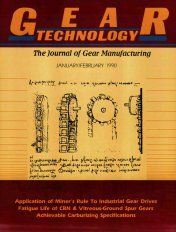Spur gear surface endurance tests were conducted to investigate CBN ground AISI 9310 spur gears for use in aircraft applications, to determine their endurance characteristics and to compare the results with the endurance of standard vitreous ground AISI 9310 spur gears. Tests were conducted with VIM-VAR AISI 9210 carburized and hardened gears that were finish ground with either CBN or vitreous grinding methods. Test conditions were an inlet oil temperature of 320 K (116 degree F), an outlet oil temperature of 350 K (170 degree F), a maximum Hertz stress of 1.71 GPa (248 ksi), and a speed of 10,000 rpm. The CBN ground gears exhibited a surface fatigue life that was slightly better than the vitreous ground gears. The subsurface residual stress of the CBN ground gears was approximately the same as that for the standard vitreous ground gears for the CBN grinding method used.
